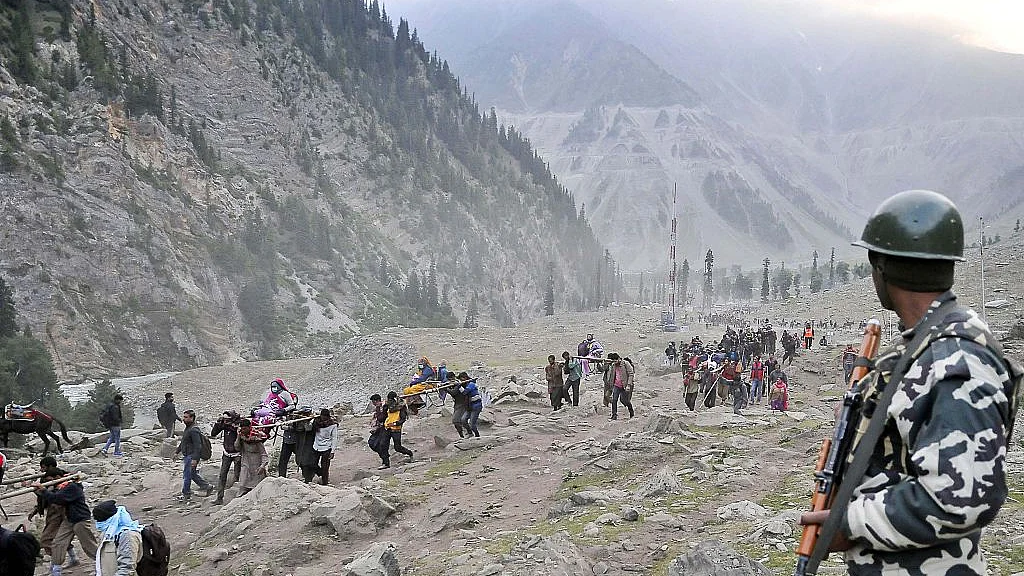Is Amarnath Yatra more political than spiritual?
What started as a fortnight-long affair has been extended to 60 days. And now attempts are on to extend the ‘state-sponsored and militarised pilgrimage’ to the rest of the year

A report compiled on ‘Amarnath Yatra—a militarised pilgrimage’ released in Srinagar this week records how the original 15-day Yatra has been extended to anywhere between 45 and 60 days with direct intervention of the state.
Attempts now appear to be on, the report says, to ensure that the Yatra is undertaken throughout the year by taking the focus away from the ice stalagmite (the lingam) which has a limited life. The focus is being shifted to the importance of the cave itself and to the mythological belief that Lord Shiva narrated the story of immortality to Parvati here.
The 212-page report is the culmination of research undertaken between 2014 and 2016 with team members undertaking the Yatra itself, embarking on it from the Pahalgam route and returning through the Baltal route.
The report makes the sensational claim that despite making efforts, they could glean no detail of how the SASB ( Shri Amarnath Shrine Board) Act was passed by the J & K Legislative Assembly in 2000-01. The team could find no media report on the deliberations in the Assembly. Nor did they find anyone who could recall any such discussion.
The team met Mian Altaf, a senior member of the National Conference and a member of the Legislative Assembly during the years 2000 – 2001. He said,“I do not remember what discussion took place, or did not take place, before the passing of the Act.” He was the Minister for Forests, Ecology and Environment, and yet he had no recollection of any discussion in the legislature.
While acknowledging that the Yatra was introduced during the Dogra rule in Kashmir, most people remember the yatra undertaken by a motley group of Sadhus during July-August. It was in the mid-eighties that the Yatra received a fillip following Gulshan Kumar of the T-series fame setting up the first langar to provide free food for the Yatris. Kumar, a film and music producer, promoted devotional songs and bhajans and the Yatra clearly helped him expand his business. Significantly, Gulshan Kumar was also responsible for promoting Vaishno Devi.
The report quotes Prof. Triloki Nath Ganjoo, a scholar based in Srinagar and a Kashmiri Pandit himself, as claiming that the Yatra was discontinued around 1752 and re-started in 1822 after the region came under Sikh rule. “The Nilamata Puran, believed to be written between 6th – 8th century AD, documents the geography, history, religion and folklore of Kashmir. In a list of pilgrimage sites of religious importance to Kashmiri Pandits, enumerated by Kanjjilal in his translation of the Nilamata Puran, there is no mention of the Amarnath Cave.”
The report adds, “Several Kashmiri Pandits, some living in the Valley and others living in Jammu and Delhi also asserted that while some people from the community do go on the Yatra, it is not religiously significant. They also shared that the day of Shravan Poornima is not celebrated as Raksha Bandhan in Kashmir. According to some of the Kashmiri Pandits interviewed, there has been no specific tradition to visit Amarnath on Shravan Poornima, instead the community visits a Shiva temple in the vicinity of their homes.”
On the issue of tradition, the Mahant of Dashnami Akhara, Deependra Giri, told the team that the religiosity of the Yatra is limited only to Raksha Bandhan and the 10 days prior to it. Lately, it is being claimed that the Yatra used to traditionally start on Jyestha Purnima (approximately a month before the Rakhi Purnima). In an interview with the Mahant, he said that “there is no such tradition and it is only being used as a tool to politicise the Yatra. The Yatra is not much else than an economic and political activity and has affected the spirituality of the Yatris themselves since nationalist sentiment is often at the core of their reason to come on the Yatra. All this has affected the atmosphere of the Yatra itself.”
Over 70% of the pilgrims seem to be from the six states of Uttar Pradesh, Gujarat, Maharashtra, Delhi, Haryana and Punjab.
The elaborate report can be accessed at jkccs.net, or equitabletourism.org
Follow us on: Facebook, Twitter, Google News, Instagram
Join our official telegram channel (@nationalherald) and stay updated with the latest headlines
- Kashmir
- Langar
- Amarnath yatra
- environment
- Dashnami Akhara
- Deependra Giri
- Shravan Poornima
- Raksha Bandhan
- Prof. Triloki Nath Ganjoo
- Nilamata Puran
- Amarnath Cave
- Gulshan Kumar
- ice stalagmite
- Shiva
- Parvati
- Pahalgam
- Baltal
- J & K legislative Assembly
- Mian Altaf
- ecology
- Dogra Rule
- sadhus